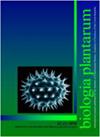Influence of water shortage on apple seedling growth under different radiation composition
IF 0.9
4区 生物学
Q4 PLANT SCIENCES
引用次数: 0
Abstract
Abiotic stresses strongly impair plant development and might impose detrimental effects particularly on seedlings. Irradiance and water deficit are relevant factors, which affect performance of young plants under controlled conditions. In our study, we investigated the influence of water shortage combined with different radiation sources - light emitting diodes (LED) and compact fluorescence lamps (CFL) - on physiological and biochemical parameters of young apple plants. Stress responses were assessed by fluorescence-based indices, while relative water, chlorophyll (Chl), and proline content served as reference parameters. The watering regime had a higher impact on biochemical indicators than the radiation sources. Lower Chl content was determined in plants grown under LED both in control and in water deficit plants. Nitrogen balance index and nitrogen balance index with red radiation excitation showed similar patterns regarding leaf Chl results in relation to the radiation source, being higher under CFL. In contrast, the flavonol index was higher in plants cultivated under LED. Stomatal conductance and maximal photochemical efficiency emphasised a radiation quality effect with higher values for CFL. In conclusion, fluorescence indices related to nitrogen status and flavonol content are promising parameters to sense physiological impairments under the given conditions. However, discrepancies compared to previous studies might be related to the different plant species, the nature of dehydration, and the measuring conditions.不同辐射成分下缺水对苹果幼苗生长的影响
非生物胁迫严重损害植物发育,并可能对幼苗产生不利影响。光照和水分亏缺是影响苗木生长发育的重要因素。本研究研究了不同光源(LED和CFL)在缺水条件下对苹果幼苗生理生化参数的影响。以相对水分、叶绿素(Chl)和脯氨酸含量为参考参数,采用荧光指标评价胁迫反应。灌水制度对生化指标的影响大于辐射源。在LED下生长的对照植株和水分亏缺植株的Chl含量均较低。与辐射源相关的叶片Chl结果中,氮平衡指数与红色辐射激发下的氮平衡指数表现出相似的规律,在CFL下更高。相比之下,在LED下栽培的植株黄酮醇指数更高。气孔导度和最大光化学效率强调了CFL较高的辐射质量效应。综上所述,在一定条件下,与氮状态和黄酮醇含量相关的荧光指标是有希望检测生理损伤的参数。然而,与以往研究相比,差异可能与不同的植物种类、脱水性质和测量条件有关。
本文章由计算机程序翻译,如有差异,请以英文原文为准。
求助全文
约1分钟内获得全文
求助全文
来源期刊

Biologia Plantarum
生物-植物科学
CiteScore
2.80
自引率
0.00%
发文量
28
审稿时长
3.3 months
期刊介绍:
BIOLOGIA PLANTARUM is an international journal for experimental botany. It publishes original scientific papers and brief communications, reviews on specialized topics, and book reviews in plant physiology, plant biochemistry and biophysics, physiological anatomy, ecophysiology, genetics, molecular biology, cell biology, evolution, and pathophysiology. All papers should contribute substantially to the current level of plant science and combine originality with a potential general interest. The journal focuses on model and crop plants, as well as on under-investigated species.
 求助内容:
求助内容: 应助结果提醒方式:
应助结果提醒方式:


